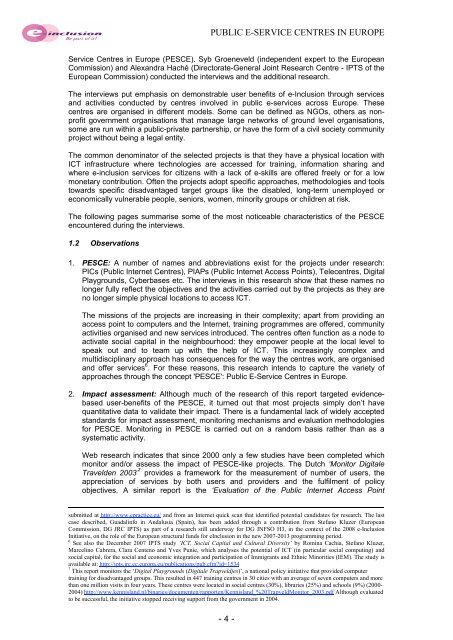Comparative Study of Public e-Service Centres in - ePractice.eu
Comparative Study of Public e-Service Centres in - ePractice.eu
Comparative Study of Public e-Service Centres in - ePractice.eu
Create successful ePaper yourself
Turn your PDF publications into a flip-book with our unique Google optimized e-Paper software.
PUBLIC E-SERVICE CENTRES IN EUROPE<br />
<strong>Service</strong> <strong>Centres</strong> <strong>in</strong> Europe (PESCE). Syb Groeneveld (<strong>in</strong>dependent expert to the European<br />
Commission) and Alexandra Haché (Directorate-General Jo<strong>in</strong>t Research Centre - IPTS <strong>of</strong> the<br />
European Commission) conducted the <strong>in</strong>terviews and the additional research.<br />
The <strong>in</strong>terviews put emphasis on demonstrable user benefits <strong>of</strong> e-Inclusion through services<br />
and activities conducted by centres <strong>in</strong>volved <strong>in</strong> public e-services across Europe. These<br />
centres are organised <strong>in</strong> different models. Some can be def<strong>in</strong>ed as NGOs, others as nonpr<strong>of</strong>it<br />
government organisations that manage large networks <strong>of</strong> ground level organisations,<br />
some are run with<strong>in</strong> a public-private partnership, or have the form <strong>of</strong> a civil society community<br />
project without be<strong>in</strong>g a legal entity.<br />
The common denom<strong>in</strong>ator <strong>of</strong> the selected projects is that they have a physical location with<br />
ICT <strong>in</strong>frastructure where technologies are accessed for tra<strong>in</strong><strong>in</strong>g, <strong>in</strong>formation shar<strong>in</strong>g and<br />
where e-<strong>in</strong>clusion services for citizens with a lack <strong>of</strong> e-skills are <strong>of</strong>fered freely or for a low<br />
monetary contribution. Often the projects adopt specific approaches, methodologies and tools<br />
towards specific disadvantaged target groups like the disabled, long-term unemployed or<br />
economically vulnerable people, seniors, women, m<strong>in</strong>ority groups or children at risk.<br />
The follow<strong>in</strong>g pages summarise some <strong>of</strong> the most noticeable characteristics <strong>of</strong> the PESCE<br />
encountered dur<strong>in</strong>g the <strong>in</strong>terviews.<br />
1.2 Observations<br />
1. PESCE: A number <strong>of</strong> names and abbreviations exist for the projects under research:<br />
PICs (<strong>Public</strong> Internet <strong>Centres</strong>), PIAPs (<strong>Public</strong> Internet Access Po<strong>in</strong>ts), Telecentres, Digital<br />
Playgrounds, Cyberbases etc. The <strong>in</strong>terviews <strong>in</strong> this research show that these names no<br />
longer fully reflect the objectives and the activities carried out by the projects as they are<br />
no longer simple physical locations to access ICT.<br />
The missions <strong>of</strong> the projects are <strong>in</strong>creas<strong>in</strong>g <strong>in</strong> their complexity; apart from provid<strong>in</strong>g an<br />
access po<strong>in</strong>t to computers and the Internet, tra<strong>in</strong><strong>in</strong>g programmes are <strong>of</strong>fered, community<br />
activities organised and new services <strong>in</strong>troduced. The centres <strong>of</strong>ten function as a node to<br />
activate social capital <strong>in</strong> the neighbourhood: they empower people at the local level to<br />
speak out and to team up with the help <strong>of</strong> ICT. This <strong>in</strong>creas<strong>in</strong>gly complex and<br />
multidiscipl<strong>in</strong>ary approach has consequences for the way the centres work, are organised<br />
and <strong>of</strong>fer services 6 . For these reasons, this research <strong>in</strong>tends to capture the variety <strong>of</strong><br />
approaches through the concept 'PESCE': <strong>Public</strong> E-<strong>Service</strong> <strong>Centres</strong> <strong>in</strong> Europe.<br />
2. Impact assessment: Although much <strong>of</strong> the research <strong>of</strong> this report targeted evidencebased<br />
user-benefits <strong>of</strong> the PESCE, it turned out that most projects simply don’t have<br />
quantitative data to validate their impact. There is a fundamental lack <strong>of</strong> widely accepted<br />
standards for impact assessment, monitor<strong>in</strong>g mechanisms and evaluation methodologies<br />
for PESCE. Monitor<strong>in</strong>g <strong>in</strong> PESCE is carried out on a random basis rather than as a<br />
systematic activity.<br />
Web research <strong>in</strong>dicates that s<strong>in</strong>ce 2000 only a few studies have been completed which<br />
monitor and/or assess the impact <strong>of</strong> PESCE-like projects. The Dutch ‘Monitor Digitale<br />
Travelden 2003’ 7 provides a framework for the measurement <strong>of</strong> number <strong>of</strong> users, the<br />
appreciation <strong>of</strong> services by both users and providers and the fulfilment <strong>of</strong> policy<br />
objectives. A similar report is the ‘Evaluation <strong>of</strong> the <strong>Public</strong> Internet Access Po<strong>in</strong>t<br />
submitted at http://www.epractice.<strong>eu</strong>/ and from an Internet quick scan that identified potential candidates for research. The last<br />
case described, Guadal<strong>in</strong>fo <strong>in</strong> Andalusia (Spa<strong>in</strong>), has been added through a contribution from Stefano Kluzer (European<br />
Commission, DG JRC IPTS) as part <strong>of</strong> a research still underway for DG INFSO H3, <strong>in</strong> the context <strong>of</strong> the 2008 e-Inclusion<br />
Initiative, on the role <strong>of</strong> the European structural funds for eInclusion <strong>in</strong> the new 2007-2013 programm<strong>in</strong>g period.<br />
6 See also the December 2007 IPTS study ‘ICT, Social Capital and Cultural Diversity’ by Rom<strong>in</strong>a Cachia, Stefano Kluzer,<br />
Marcel<strong>in</strong>o Cabrera, Clara Centeno and Yves Punie, which analyses the potential <strong>of</strong> ICT (<strong>in</strong> particular social comput<strong>in</strong>g) and<br />
social capital, for the social and economic <strong>in</strong>tegration and participation <strong>of</strong> Immigrants and Ethnic M<strong>in</strong>orities (IEM). The study is<br />
available at: http://ipts.jrc.ec.<strong>eu</strong>ropa.<strong>eu</strong>/publications/pub.cfm?id=1534<br />
7 This report monitors the ‘Digital Playgrounds (Digitale Trapveldjes)’, a national policy <strong>in</strong>itiative that provided computer<br />
tra<strong>in</strong><strong>in</strong>g for disadvantaged groups. This resulted <strong>in</strong> 447 tra<strong>in</strong><strong>in</strong>g centres <strong>in</strong> 30 cities with an average <strong>of</strong> seven computers and more<br />
than one million visits <strong>in</strong> four years. These centres were located <strong>in</strong> social centres (30%), libraries (25%) and schools (9%) (2000-<br />
2004) http://www.kennisland.nl/b<strong>in</strong>aries/documenten/rapporten/Kennisland_%20TrapveldMonitor_2003.pdf Although evaluated<br />
to be successful, the <strong>in</strong>itiative stopped receiv<strong>in</strong>g support from the government <strong>in</strong> 2004.<br />
- 4 -
















